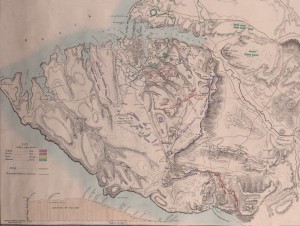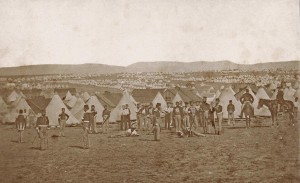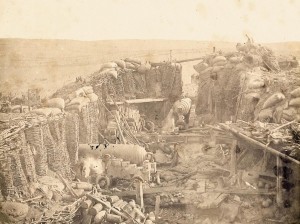![Camp of the 97th Regiment in front of Sevastopol [Ukraine], by James Robertson or Felice Beato, c. Sep 1855 (Ref: Ne C 10884/2/13)](https://blogs.nottingham.ac.uk/manuscripts/files/2013/08/Ne-C-10884-2-13.jpg)
October 15, 2013, by Kathryn Steenson
The Crimean War on Camera
This month sees the 160th anniversary of the start of the Crimean War (October 1853 – February 1856), between the Russian Empire and an alliance of French, British, Sardinian and Ottoman forces.

Detail from the ‘Seat of War in the Krimea’, 1855, showing the positions of the English (red), French (blue), Turkish (yellow) and Russian (green) camps (Ref: MS405)
As the Ottoman Empire declined, various European nations attempted to assert their influence over its territories. Fighting took place mostly in the Crimean peninsula, today an autonomous republic within the Ukraine, but smaller battles also took place in and around modern-day Turkey and the Caucusus.
Popular imagination associates it with two things: the Charge of the Light Brigade (both the disastrous military advance and Alfred, Lord Tennyson’s poem about it, both dated 1854); and Florence Nightingale (1820-1910) and the birth of the nursing profession. Whilst the horses, cannon and incomplete understanding of disease transmission make the war seem very distant and remote, arguments have been made that it was one of the first wars of the ‘modern’ era.
Railways and telegraphs were used tactically for the first time. The British built the Grand Crimean Central Railway for the purpose of supplying food and ammunition to soldiers during the Seige of Sevastopol. A 300-mile long, underwater telegraph cable (the longest in the world at that time) laid in the Black Sea separating Varna and Balaclava allowed the French and British forces to communicate almost instantaneously. Other improvements in communications and the relatively-new medium of photography allowed war correspondents’ and photographers’ accounts to be published quickly and regularly in the press.

Camp of the 97th Regiment in front of Sevastopol [Ukraine], by James Robertson or Felice Beato, c. Sep 1855 (Ref: Ne C 10884/2/13)

Part of the Redan at Sevastopol, Ukraine, by James Robertson or Felice Beato, c. Sep. 1855 (Ref: Ne C 10884/2/23)

English burial ground on Cathcart Hill, Crimea, Ukraine, by James Robertson, c. Sep. 1855 (Ref: Ne C 10884/2/5)
No comments yet, fill out a comment to be the first

Leave a Reply